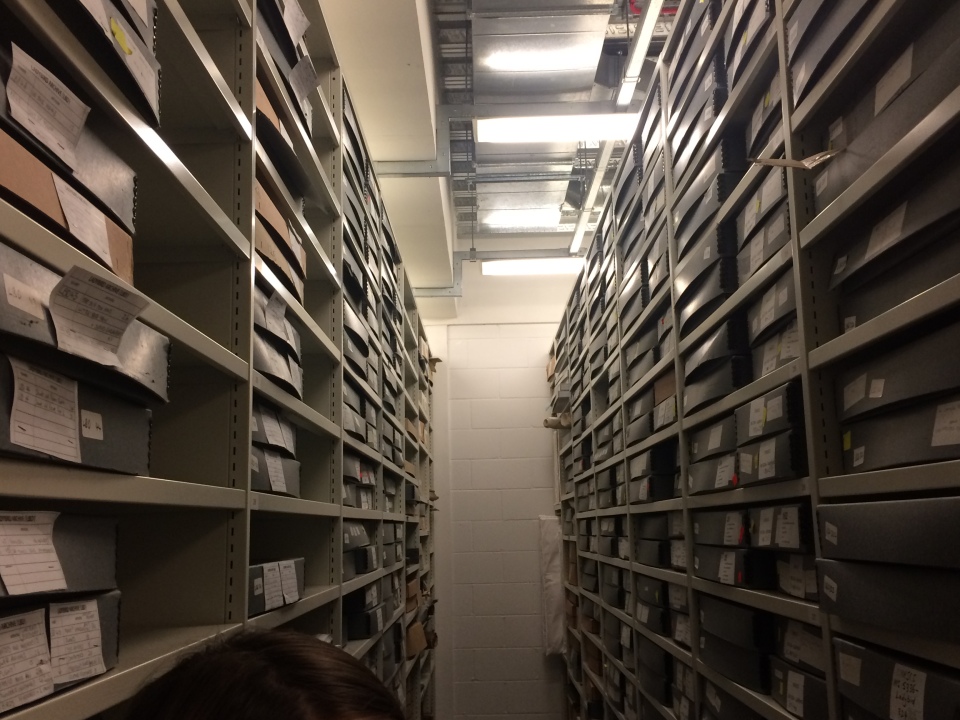The Architect, Frederick Gibberd, and Landscape Architects, Colvin & Moggridge, were prolific contributors to the post-WWII redevelopment programme, being involved in schemes of all scales, from residential and New Towns to hospitals, airports and reservoirs. Last week, we were delighted to introduce M.Arch students from the Manchester School of Architecture (MSA) to archival research through visits to the Gibberd Archives in Harlow and the Archives of the Landscape Institute, held at the Museum of English Rural Life (MERL), Reading in order to explore materials relating to the work of these practices on power stations. The visits were part of our post-graduate unit, Research Methods, that aims to equip students with various methodologies for their dissertations. Our unit, Architecture, Landscape, Infrastructure is linked to our research projects, and directly links our academic research with our teaching.
The visits were immensely successful and we were privileged on a number of accounts:
Our first stop was to the Gibberd Garden in Harlow, Essex, where the collections of Frederick Gibberd are held. Gibberd, perhaps most famous for the contemporaneously controversial Metropolitan Cathedral in Liverpool, was a prolific Architect and landscape designer pioneering design in major projects including New Towns, such as Harlow, which later became is home town. With a specific interest in Didcot Power Station, where Gibberd was responsible for both the architecture and landscape at the site, we were briefly immersed in Gibberd’s world through the surroundings of his remarkable house and gardens,[i]and supported by dedicated volunteers, many of whom were friends of Gibberd and his family. We were treated to Gibberd’s diaries; folders of notes, letters, newspaper clippings and journal articles, relating to his architectural interests and how his work was perceived by the mainstream and architectural press. The drawings for Didcot power station are now held by the RIBA Archives at the V&A, London, but we were treated to documents and drawings of his work for Hinkley Point B.
Unfortunately, without much time to dwell on the delights of Gibberd’s work on Harlow New Town, other than a brief tour by Moira, a personal friend of the late Pat Gibberd, on our return to the station, we headed to Reading eager to feat our eyes on the 100s of Brenda Colvin’s drawings of Rugeley Power Station. We can confirm that these certainly did not disappoint!
Our day at MERL began with an introduction to archives and archive materials from Guy Baxter. Hopefully armed with a new enthusiasm for fusty old drawings, Nicola Pickering of Museum Studies at the University of Reading spoke to the students about designing and curating exhibitions using archive materials in preparation for translating their findings at the archives into case studies of four post-war power stations and eventually an exhibit to be held in Manchester in February 2019.
Our post-war infrastructure celebrity of the day was Hal Moggridge, practice partner of Colvin & Moggridge and, of course, close friend of the late Brenda Colvin. Hal had agreed to be interviewed by our students, who were keen to mine his vast knowledge of landscape and architectural designs of the period. Lengthy discussions about his work were had, and we were all truly privileged to discuss drawings of Eggborough Power Station made by Hal’s own hand and now held in the Landscape Institute Archives at MERL[ii].
Forming part of the Research Methods focus week at the MSA, our aim was to introduce students to archival resources and research and interview methods. Documenting and recording Rugeley drawings was a lengthy task, which the students’ relentlessly tackled with enthusiasm and unified teamwork; a characteristic of MSA students. The next step in their research will be to use their skills as designers to analyse the materials they have collected and compile case studies of Rugeley, Didcot, West Burton and Trawsfynydd power stations.
As researchers, we are undoubtedly delighted by potential and opportunities that have resulted from our recent visits, and from our position as teachers it has been a great opportunity to introduce the next generation of landscape and architecture researchers – to whom the future of infrastructure belongs – to both research methods and the subject matter.
We are really excited about the opportunities for further work with the archivists that emerged from our recent visit. Watch this space for news of forthcoming exhibitions!
The visit was made possible through combined financial support of the Paul Mellon Centre for Studies in British Art Education Grant and the Manchester School of Architecture.



 We greatly appreciate the support of the volunteer team at the Gibberd Garden and Guy Baxter and Jennifer Glanville at MERL for their interest and support with our research. We are also indebted to Hal Moggridge for his time and fascinating descriptions of the work of Colvin and Moggridge. A special mention goes also to Prof. Tom Jefferies for his support of the project and to our dedicated students, who we hope gained a valuable experience from the project.
We greatly appreciate the support of the volunteer team at the Gibberd Garden and Guy Baxter and Jennifer Glanville at MERL for their interest and support with our research. We are also indebted to Hal Moggridge for his time and fascinating descriptions of the work of Colvin and Moggridge. A special mention goes also to Prof. Tom Jefferies for his support of the project and to our dedicated students, who we hope gained a valuable experience from the project.
[i]The Gibberd Garden is run by volunteers and is open to the public throughout the summer. We wholly recommend a visit!
[ii]The archives at MERL are accessible to the public, but as with most archives require registration for access.
https://merl.reading.ac.uk/merl-collections/collection-overview/archives/

